Private Label – I started off as a seller myself (and still sell on Amazon). It’s important to have skin in the game. But it’s not enough…
What We All Know but Don’t Do
My own Amazon business did $100,000 in sales in the first two years of
its existence. Since between myself and business partners our Amazon businesses have topped $250K in sales. This was a good start for helping others… but there was another key to this…
The next key is that teaching others helps clarify your own processes. I’ve been mentoring beginners to ecommerce since April 2016, with some great wins. See case studies at the end if you’re interested. However, that’s still flawed… but there is a solution…
The flaw? Many sellers create a course based on their own very narrow experience of success with a handful of products. That’s not a good basis for generalization. The solution…model the peak performers.
Here’s what this guide (and our work) is based on:
- Interviewing serious power sellers mostly American for the podcast
- Private connections in the UK to Power Sellers (over £100k/month)
- The 10K Collective Masterminds (collective turnover around £12/$15 mill a year) This group, which I’ve run since Sept. 2017, is full of power sellers. The most successful sellers in that have about doubled turnover since they joined (just over a year at the time of writing). (**UPDATE** Dec. 2018 the biggest seller just texted me to say he was having his first million-pound month)
“Success leaves clues. The power sellers I know – probably about 40 of the USA’s 7 figure sellers, do things differently. At Infinite Prime we capture, codify and pass that informative relationship, retention and result driven data on to each client.”
Dean Masalta
How to Learn More with $600 Than $6,000
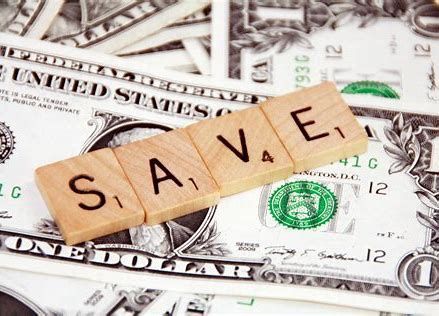
What is Arbitrage?
It’s like buying apples from a fruit and veg stall in the East End for £0.10 each, then selling them for £0.50 each in a posh shop in Hampstead (Americans insert own cultural references here!) It’s the basis of all successful trading, in fact domestic or international. Retail Arb.
Means buying a product in a retail store like Tesco, Argos etc. selling on Amazon for a higher price and pocketing the difference.
Is Arbitrage a good alternative to Private Label?
Not anymore. It’s getting hard to compete. The business can’t really be sold. You’re not learning to have products created, or to import. I’m not suggesting you create an arb business. But it does solve a crucial problem…
So why do Arbitrage if I want to Private Label?
Simple…Arbitrage is just a starter motor for the Formula 1 engine that is a fully fledged Amazon private label business. A starter motor won’t win you a F1race.
Yet, without it, you’re looking at hand cranking your engine! That’s old school in a really BAD way! Arbitrage IS excellent for learning Amazon basics shipping to Amazon warehouses, navigating the Seller Central while risking small money. It’s easy, quick & low risk.
The NSL Process
The big issue is…NOT what you think
- Clients come thinking: “I don’t know what to sell. So, what I need is a product type /keyword.”
- You may be feeling the same. You’re right for now. Sadly, that is not really going to serve you in the future, though.
- Undoubtedly the biggest issue is actually confusion about the process of how to find a good product.
“Give a man a fish, and you feed him for a day;
Teach a man to fish, and you feed him for a lifetime.”
The overall process is critical. You need to know.
What the process is (and that it works see steps)
Where you’re personally at in the process
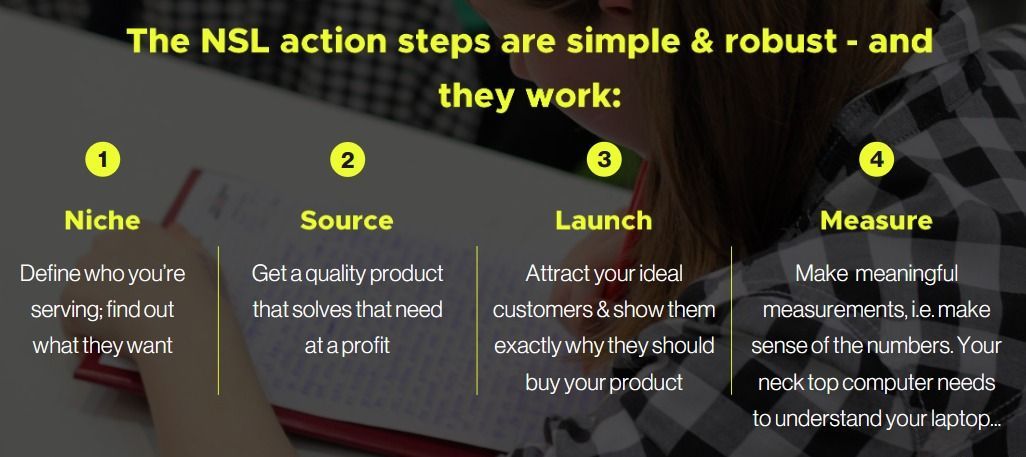
Avoid the Traps: Waste $5,000+
- Aside from confusion, there are two big blocks to seller progress. These work at the highest 50,000-foot level. It’s really about an excess of two big errors: Fear and naïve hope.
- Being scared off by potential $5,000 errors and going in circles. Slow Death!
- Spending all your money on one private label product launch; it doesn’t perform as hoped; leaving the game. We call this the “moon shot” model. (High goals but very high risk).
- Neither is ideal; fortunately, neither is necessary, either.
Our Process works way more often than the traditional “Moon shot approach:
Phase Zero: Learn your basic Amazon skills with Retail/Online Arb. Source Get a quality product that solves that need at a profit
Phase One: Learn your craft skillset AND mindset while testing a market with an “Assess” test launch selling a generic/off the shelf product.
Phase Two: Go for profit with your Private Label full scale launch with confidence and experience behind you.
We call this the “Space Shuttle” approach. Sure, a launch still takes effort. But, like the Space Shuttle, the approach is designed for multiple smaller launches rather than one big push with everything at stake.
Product Reseach Fails: Do this Instead!

(PART A) Believe You’ll find the Right Product using Helium10 or Jungle Scout? Yes and no…
- We don’t believe you’ll find success by just plunging into analyzing products on Amazon. Why? It’s all about one critical element. To find that element, we work smarter upfront, so we can reap the benefits later. We break our product research into two parts: A, & B. This is all about starting with a person not a product.
- (By the way-that critical element? Differentiation. Being substantially different from the other products out there in a way that your market cares about.)
Brainstorm: THINK “Person and Pain”. Be person centered, not product centered.
Start with Yourself: Hobbies? Work? Partner, Family, Friends
Don’t just brainstorm alone: Community e.g. Facebook Group; Reddit; offline Communicate -observe; listen; ask Comprehend -dig deep; get REAL answers.
Use Tools: Easy and quick sound good, don’t they? There’s a problem though. Sadly, easy and quick mean that everyone else is using the same tools. That means everyone is coming up with the same product “ideas”. Far better to start with your human brain and start with human needs, not numbers (they’re important but they come next).
(PART B) Product Idea Elimination aka PIE
Want a slice market share of a (juicy PIE) market? Now is a time to crunch a few numbers on Amazon. But how do you read that correctly?
Hungry Crowd: We want people who don’t just search for a solution in large numbers but really want a solution NOW. BUT if there is under $5000 total revenue on page 1 of results, it’s time to move on
The critical step that often leads to a failed launch… If a market is worth winning, next thing is to check if it is winnable for you.
BRAND: Is there a brand with >30% of revenue? Or a Household Brand?
LISTINGS: Does brand have multiple listings in the same keyword search?
REVIEWS: : Do the top products all have 100s/1000s of reviews? What is
average rating?
Don’t skip this or you’ll struggle to differentiate…
- If a market is worth winning AND winnable, next thing is to check the major players in your market.
PHOTOS: Do they use all 9? Boring or engaging?
WORDS: Are they keywords rich? Do they use benefits clearly? Can you, in brief, do better?
KEYWORD RANKING: How do the top products rank for individual keywords? Is one easier to win?
The Two Keys to Great Sourcing

These are obvious but yet people lose sight on them.
- Good enough quality to avoid 1* reviews from fussy Amazon consumers.
- A low enough buy price to be profitable when selling at market price.
- Not really defining what you are looking for.
China manufactures 80% of the world’s products. Its selection is just vast. Your job is to drill down. Only clarity will give the focus that lets you cut through with laser like precision. The simplest starting point is: alibaba.com
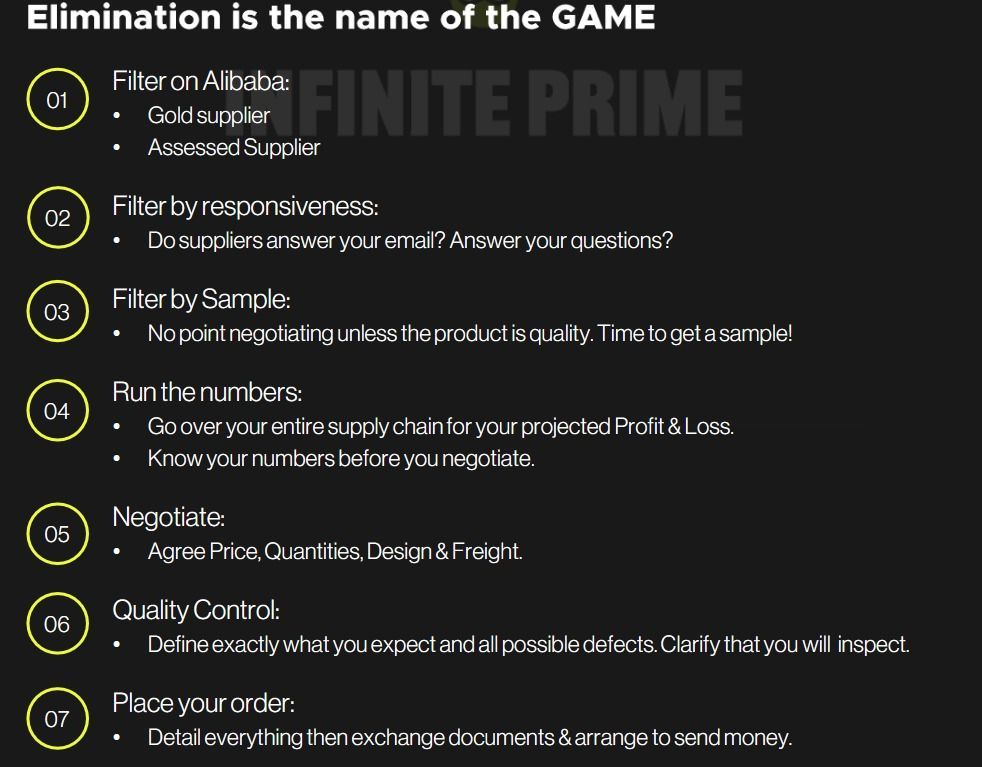
The New Old School Launch that Works – Why more traffic is NOT the answer…
Having a listing that doesn’t convert visitors to sales is like spending hours on the phone setting up sales appointments…then giving the leads to a terrible salesman. Always maximize your listing’s chances of making sales before doing the really expensive bit: sending traffic…
Exactly who are you selling to?
As well as demographics (age, sex, location, income), try to define psychographics (values, drivers, etc.)
Precisely what pain are you solving?
Solving arthritis? Which kind? What location? Brought on by what activity? What is the “Ultimate Pain” you’re solving? Mobility? Thus freedom? Why overlooking numbers can lose you lots of cash…
Craft your Words
- Tone of voice matters. On Amazon, so does energy (especially in the USA).
- Give your listing punch and personality
Fantastic Photos
- Engage an exceptional product photographer.
- Collect product images you like into a virtual scrapbook (Pinterest is excellent)
- Make a clear brief for your photographer based on your other work above.
- Include “lifestyle” shots (product in context) and use models if you can.
(Hint -photos on a white background isn’t going to give you a great result)
What do you do with your keywords?
- Exactly which top 5 keywords are both winnable and worth winning (in terms of ranking ie where your listing appears in the search results)?
- What are your 15-20 long tail keywords? (Lower search volume but very relevant)
What are your traffic Channels?
- Amazon Ads? (this is the mainstay) Launch Services (Jump Send, Viral Launch)?
- Facebook Ads to Chabot?
Don’t leave this out money planning either
- If you’re selling below breakeven, how much will each sale cost you?
- Plan your ad costs -assuming that most of your sales will come via
- Amazon ads to start with
Make this critical error and you could be wasting all your ad spent!
- Use software (like CashCowPro, Zonguru, etc.) to track your ranking for all keywords you think might be important.DO THIS BEFORE YOU RUN TRAFFIC!! If you don’t, you are “driving blind” with your Amazon ads. Why? Because the whole point of Amazon ads is to drive ranking for specific keywords
You won’t love this, but it is the KEY to success!
- Know your numbers, what is your breakeven price without ads?
- Set your price to breakeven to start (below breakeven if you can bear it!)
- Gradually raise your price to when you start to achieve your target keyword rankings (see below)
How to set up your Amazon Sponsored ads
- Set an auto campaign with an aggressive bid per click (say $2-5) and strong
- daily budget (say $20-100/day)
- Set up a manual campaign with your top 5 keywords and 20 long tail keywords.
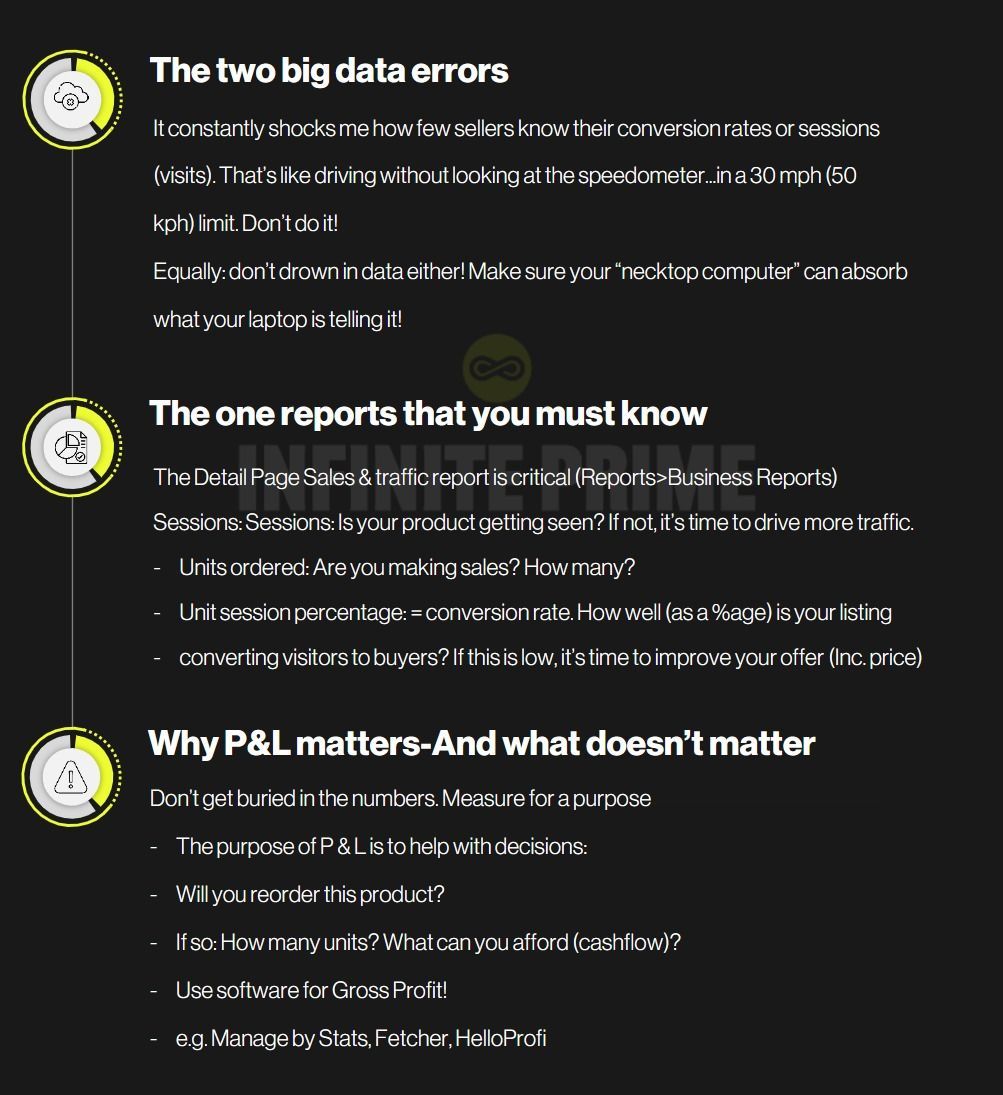
The critical metric for amazon ads (Hint-not Acos)
Find Amazon Ads Start
- Find these under Advertising>Campaign Manager
- If you’re launching, expect to spend a LOT initially. That’s fine IF you’re gaining keyword ranking for valuable keywords as a result. Track this!
- Overall picture by campaign: Monitor for either really good (profitable) or really bad (expensive) results
Measured Keyword by Keyword for manual campaigns
- Look for sales -are you driving sales and ranking?
- Next look for clicks -are you telling the algorithm to rank your listing?
- Check CTR (Click-Through Rate). Over 0.7% is good for ranking
The really important metrics: ATS
- Take the ad-spend on a product for a period.
- Check your overall sales (Business reports) for the same period.
- Calculate your ad-to-sales ratio (ATS). If it’s high in launch period, that’s fine.
- After launch, aim for about 10% overall.
- You can ignore ACoS unless it’s super high (over 100%). It’s a red herring
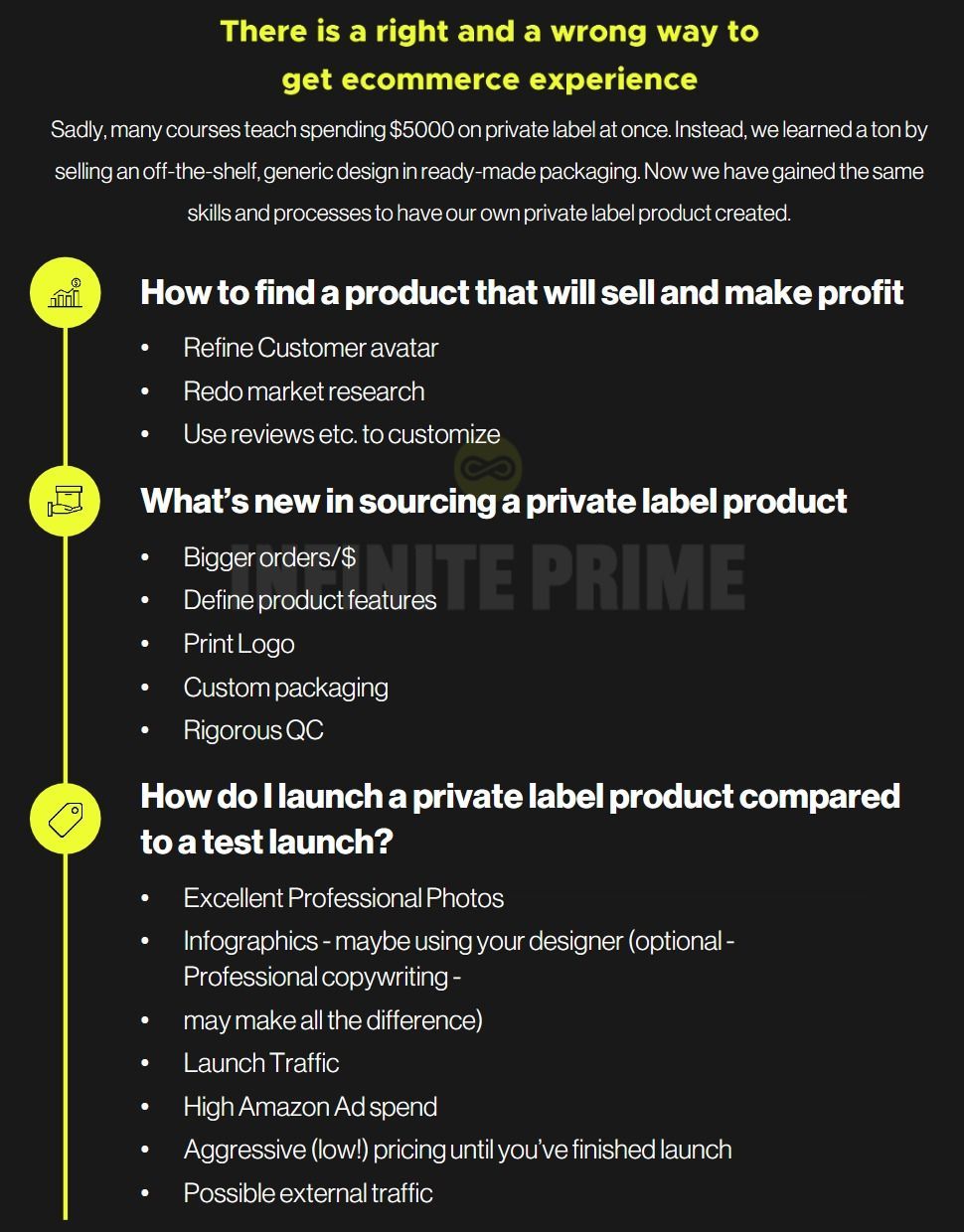
Author and Creator: Dean Masalta
You don’t have to do it alone. We have a full-service Amazon growth team that can help you take advantage
of everything the retail giant offers its sellers.


Scopians
Hi my loved one I wish to say that this post is amazing nice written and include approximately all vital infos Id like to peer more posts like this